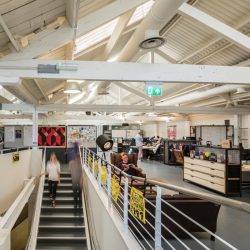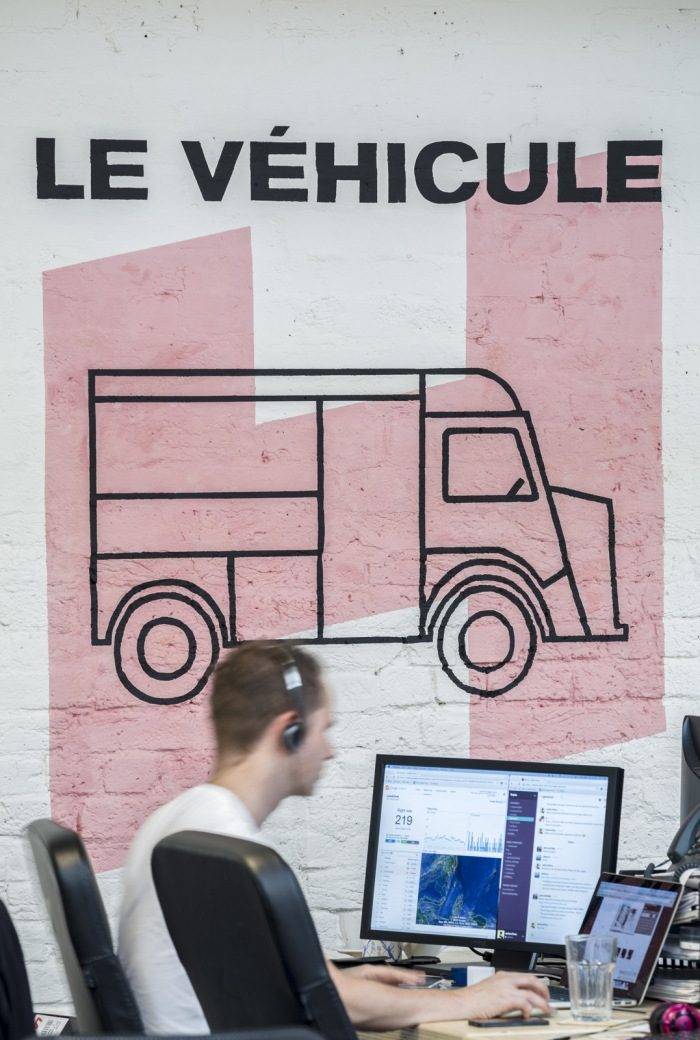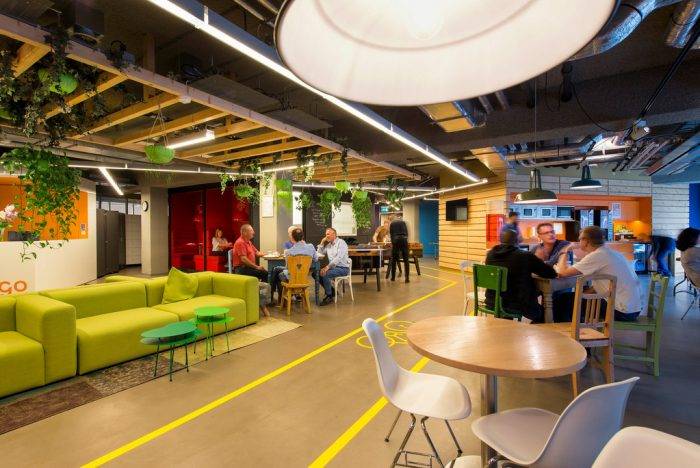 Workplace people are at risk of obsessing about productivity. The idea of what is or is not effective and even the notion of wellbeing, has almost been done to death. We overthink stuff. As Neil Usher might say, there are a few bandwagons people are leaping on a little too eagerly. So, let’s keep it simple. Yes, we need a ‘space’ to work in (or just do stuff), but mostly we need a reason for using it in the first place. One thing most people agree on – even the media and flinty-eyed consultants – is that we need a motivation, a reason to do the things asked of us and a belief or intrinsic connection to do those ‘things’ well.
Workplace people are at risk of obsessing about productivity. The idea of what is or is not effective and even the notion of wellbeing, has almost been done to death. We overthink stuff. As Neil Usher might say, there are a few bandwagons people are leaping on a little too eagerly. So, let’s keep it simple. Yes, we need a ‘space’ to work in (or just do stuff), but mostly we need a reason for using it in the first place. One thing most people agree on – even the media and flinty-eyed consultants – is that we need a motivation, a reason to do the things asked of us and a belief or intrinsic connection to do those ‘things’ well.
This connection is not just about having a passion for your job, the organisation you work for, or the people around you. It is about having a connection with the brand. Before you begin rolling your eyes, we must be careful not to slip into business jargon and not over complicate things. Passion is important, but what really counts is giving your employees a reason to behave in a certain manner. For example, great customer service – and therefore productivity and effectiveness – is about motivation: having a reason why.
Many of the young high growth organisations emerging now believe it’s very important for employees to understand the purpose and vision of the organisation, particularly when they are starting out. That purpose and vision stems from the brand. It’s a reflection of our social democratic society. There’s an emphasis on ‘engagement’.

Rapha (and main image)
Hence why Stewart Redpath, a director at Liminal Marketing, once claimed he “can ’smell’ the culture of an organisation within three minutes of entering their offices.” Bold talk, but what he says makes sense. People everywhere want to feel valued, to enjoy work. We all (yes, even the most cynical) crave professional satisfaction and fun, and most of us want to feel secure in teams and be part of a ‘family’.
What Redpath is arguing for is a ‘Branded workplace’. What he means is that the workplace designers create should not be full of distressed brickwork and bright bulbs for the sake of it. Too many workplaces are decorated with branding and not designed. It is not enough to put up copious amounts of corporate branding, logos and posters extolling the values. Instead the space should reflect the purpose of the given brand in the workplace. If the brand is a brick or block manufacturer, then yes, that design might allow for some bricks. Just maybe not distressed ones.
Good examples of this approach might be Vodafone and its redesigned space in the Netherlands, and our personal favourite Rapha. The new Vodafone office was designed to promote a ‘mobile working’ concept which applied mobile work, speed, simplicity and trust. Rapha, the UK cycling clothing manufacturer, decided everything about the business has a high design cred running through it. To this end, they decreed that everything the company made or did would communicate their passion for the sport through design – including its workspaces.
The design of a space is not like a magic wand. The brand, the motivation and the reason why are either part of an organisation’s DNA or not. But its culture and values can be brought to life and ‘connected’ by better design. The security of team spirit, the sense of family and belonging, can be enhanced and fostered by a well-designed space.

Vodafone
But let’s not get carried away. There’s an argument that this idea of focussing on ‘purpose’ has been exhausted. Another bandwagon arriving with a fanfare at a workplace conference. Darren Gordon at BeBoundless says that whilst ‘purpose’ certainly feels like an eternal truth, and is strongly backed up by research, its overuse has diminished its meaning and left the “flinty-eyed consultants” eager to come up with a new attractive term to sell. Perhaps, in the near future, a ubiquitous purpose will not be attractive to workers. Will workplace consultants follow or lead the next evolution?
The case is made here that workplace design builds on a clear definition of brand. But Darren has another hand grenade to throw in: “What happens when the workplace consultant walks into their first meeting to discover that the brand is incoherent and inconsistent. What then? Should the consultant leave their business card and walk out? If not, where should they start?”
Is there a case for creating a pop-up space within a workplace that creates the conditions for new thinking? This pop-up space could be temporary, counter-culture, and provocative. Its ‘smell’ would be completely different to the aroma of the rest of the organisation. Perhaps this would confuse Stewart Redpath in his first three minutes.
Good workplace design is not a panacea for productivity, effectiveness or even wellbeing. But it can help identify and then connect with the reason why. Leadership, vision and business sense create the brand values – but good design can bring them to life. What designers and consultants need to avoid is being carried away with brand new shiny ideas. Sometimes we just need to focus on the space, check what works, assess what is needed and determine what will be functional.
Then as a final test, we can send in Stewart Redpath to sniff out the brand aroma. So, have a think: would your workplace pass that branded smell test?
Images: Rapha office by Jump Studios. Vodafone by Evolution Design.
___________________________________________
 Steve Brewer is a partner at workplace design consultancy Burtt Jones & Brewer
Steve Brewer is a partner at workplace design consultancy Burtt Jones & Brewer


















February 5, 2018
Developing a cultured nose for what makes workplace design great
by Steve Brewer • Comment, Workplace design
This connection is not just about having a passion for your job, the organisation you work for, or the people around you. It is about having a connection with the brand. Before you begin rolling your eyes, we must be careful not to slip into business jargon and not over complicate things. Passion is important, but what really counts is giving your employees a reason to behave in a certain manner. For example, great customer service – and therefore productivity and effectiveness – is about motivation: having a reason why.
Many of the young high growth organisations emerging now believe it’s very important for employees to understand the purpose and vision of the organisation, particularly when they are starting out. That purpose and vision stems from the brand. It’s a reflection of our social democratic society. There’s an emphasis on ‘engagement’.
Rapha (and main image)
Hence why Stewart Redpath, a director at Liminal Marketing, once claimed he “can ’smell’ the culture of an organisation within three minutes of entering their offices.” Bold talk, but what he says makes sense. People everywhere want to feel valued, to enjoy work. We all (yes, even the most cynical) crave professional satisfaction and fun, and most of us want to feel secure in teams and be part of a ‘family’.
What Redpath is arguing for is a ‘Branded workplace’. What he means is that the workplace designers create should not be full of distressed brickwork and bright bulbs for the sake of it. Too many workplaces are decorated with branding and not designed. It is not enough to put up copious amounts of corporate branding, logos and posters extolling the values. Instead the space should reflect the purpose of the given brand in the workplace. If the brand is a brick or block manufacturer, then yes, that design might allow for some bricks. Just maybe not distressed ones.
Good examples of this approach might be Vodafone and its redesigned space in the Netherlands, and our personal favourite Rapha. The new Vodafone office was designed to promote a ‘mobile working’ concept which applied mobile work, speed, simplicity and trust. Rapha, the UK cycling clothing manufacturer, decided everything about the business has a high design cred running through it. To this end, they decreed that everything the company made or did would communicate their passion for the sport through design – including its workspaces.
The design of a space is not like a magic wand. The brand, the motivation and the reason why are either part of an organisation’s DNA or not. But its culture and values can be brought to life and ‘connected’ by better design. The security of team spirit, the sense of family and belonging, can be enhanced and fostered by a well-designed space.
Vodafone
But let’s not get carried away. There’s an argument that this idea of focussing on ‘purpose’ has been exhausted. Another bandwagon arriving with a fanfare at a workplace conference. Darren Gordon at BeBoundless says that whilst ‘purpose’ certainly feels like an eternal truth, and is strongly backed up by research, its overuse has diminished its meaning and left the “flinty-eyed consultants” eager to come up with a new attractive term to sell. Perhaps, in the near future, a ubiquitous purpose will not be attractive to workers. Will workplace consultants follow or lead the next evolution?
The case is made here that workplace design builds on a clear definition of brand. But Darren has another hand grenade to throw in: “What happens when the workplace consultant walks into their first meeting to discover that the brand is incoherent and inconsistent. What then? Should the consultant leave their business card and walk out? If not, where should they start?”
Is there a case for creating a pop-up space within a workplace that creates the conditions for new thinking? This pop-up space could be temporary, counter-culture, and provocative. Its ‘smell’ would be completely different to the aroma of the rest of the organisation. Perhaps this would confuse Stewart Redpath in his first three minutes.
Good workplace design is not a panacea for productivity, effectiveness or even wellbeing. But it can help identify and then connect with the reason why. Leadership, vision and business sense create the brand values – but good design can bring them to life. What designers and consultants need to avoid is being carried away with brand new shiny ideas. Sometimes we just need to focus on the space, check what works, assess what is needed and determine what will be functional.
Then as a final test, we can send in Stewart Redpath to sniff out the brand aroma. So, have a think: would your workplace pass that branded smell test?
Images: Rapha office by Jump Studios. Vodafone by Evolution Design.
___________________________________________